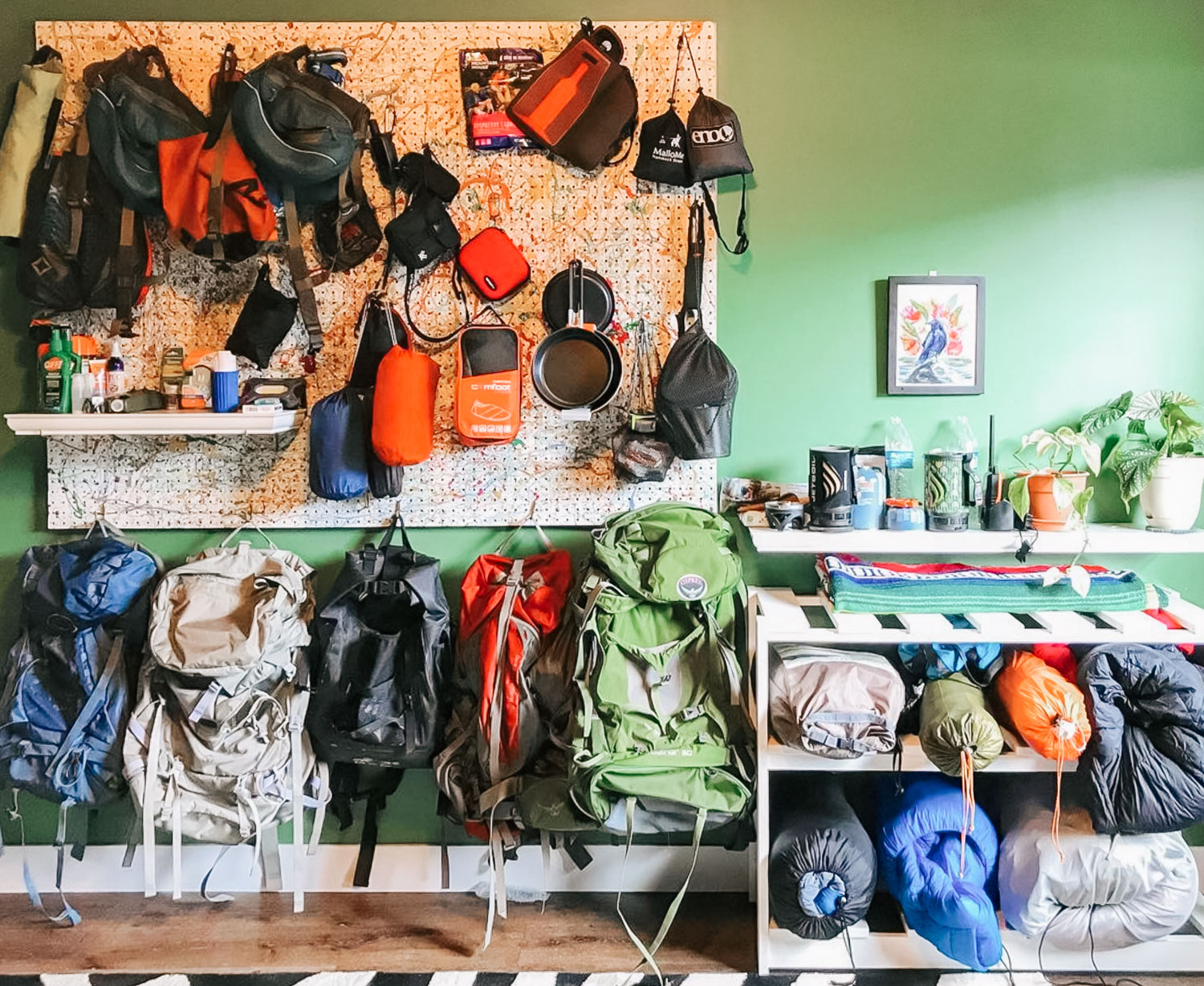End-of-Season Camping Gear Care + Storage

End-of-Season Camping Gear Care + Storage
Our best tips for how to clean, repair, & store your camping gear
by Hailey Hirst and Tori Duhaime
Banner image by Hanna Davis
Proper care and storage of the outdoor gear you acquire is important for so many reasons… It lengthens the lifespan of goods, keeps textiles out of landfills, saves you money when you don’t need to replace items, and makes it easier to find things when you need them.
As the seasons shift and we swap out summer hiking items for colder-weather goods, here are some best practices for cleaning, repairing, and storing your outdoor gear until spring:
CLEAN
Read your gear tags, manuals, etc.
This is the best way to see if the manufacturer has specific suggestions for how your gear can be washed, maintained, and stored for long periods of time. When in doubt, look it up!
Start with the shakedown.
Check pockets, compartments, nooks and crannies for any snacks, wrappers, crumbs, and trash from your adventures. Leftovers could attract ants or cause some unwanted science experiments!
Wash your textiles.
Let’s be honest—when’s the last time you washed your puffy coat and sleeping bag? Or wiped down your tent inside and out? Regularly cleaning your gear from body oils, bug spray or sunscreen, and other spills can make a huge difference in the longevity of the materias.

When’s the last time you washed your boots, tent, or pack? — photo by Hailey Hirst
Check if machine washing is approved for your textiles, and wash away! When laundering, keep in mind that Wool Wash or Woolite is more gentle than traditional laundry detergents for base layers, and products like Tech Wash are meant to safely clean technical fabrics—including hiking boots, along with your tent, sleeping pads, and backpacks.
Clean cookware and drinkware thoroughly.
No matter how good you are at camp cleaning, an extra wash of all cookware, containers, water bottles and bladders, etc. never hurts. Water filters should also be fully washed and dried prior to storing.
Be sure your gear is dry before stashing it away.
Mold and mildew are never pleasant the next time you’re setting up camp. Even if you’re not deep cleaning every item, it’s worth laying out your gear to dry for a day or two before packing it away. Remember to let the inside of items like sleeping pads dry, too. Keep those valves open for airflow!
REPAIR AND REFURB
Patch or mend rips, holes, and tears.
Hopefully you’ve kept the patch kits that come with items like sleeping pads, and if not, duct tape might help… for a while. More permanent fixes can be found in products like Noso patches, Gear Aid aquaseal, Tenacious Tape are perfect for tents and other gear. As for rips or holes in clothing? Mending can extend the life of jackets, socks, thermal layers, and more! Plus, visible mending is on-trend now, and adds personality to your storied objects.
Refresh your waterproof items with durable water resistant spray.
If you find your waterproof jacket doesn’t seem to be resisting water as much anymore, look for some waterproofing spray or wax, just be sure you pick a method compatible with the fabric type.
Fix what’s broken.
Broken tent poles, missing stakes, leaky tubes, lost fasteners, broken zippers… none of these issues necessarily mean you need to replace the whole item. If you can’t fix it yourself, outdoor gear shops (including REI) offer repair services to help extend the life of your goods and prevent you from spendy replacements on the bigger-ticket items.
ORGANIZE AND STORE
Choose a suitable storage location.
Temperature extremes and moisture can harm some of your gear, so when deciding where to store your goods, avoid anywhere damp or exposed to temperature swings if possible. (For example, the truck of your car and uninsulated attics are not ideal.)
Revisit those instructions.
Tents and sleeping pads might need to be folded (or not!), and stored in certain ways—and they probably come with offered instructions.

A beautiful example of organized bins, shelf storage, and properly-hung sleeping bags — photo by @geartest_outdoors
Sleeping bags and anything down-filled or inflatable are best stored hanging up.
Hanging rather than staying stuffed in a sack preserves the insulation. Try clipping a carabiner to the bottom loop of your sleeping bag and hanging it from the ceiling. Same goes for inflatable sleeping pads!
Bins can be your best friend.
When you’re storing gear in garages, crawl spaces, or atticks, plastic bins with lids are a great way to keep gear clean, dry, and free from pests. Even if you’re utilizing a closet, bins are optimal for organization if you’re sorting or stacking.
This was originally shared, in part, as a Trail Kit Thursday post on the She Explores Instagram (written by Tori Duhaime). Head to @she_explores to follow along, and discover more gear posts in our blog under “Gear + Goods.”
- About the Author
- Latest Posts

Hailey Hirst is She Explores‘ digital content editor and brand designer. Her leash-trained tuxedo cat and young daughter join her on the trails close to home in British Columbia and Idaho.
Be the first to comment